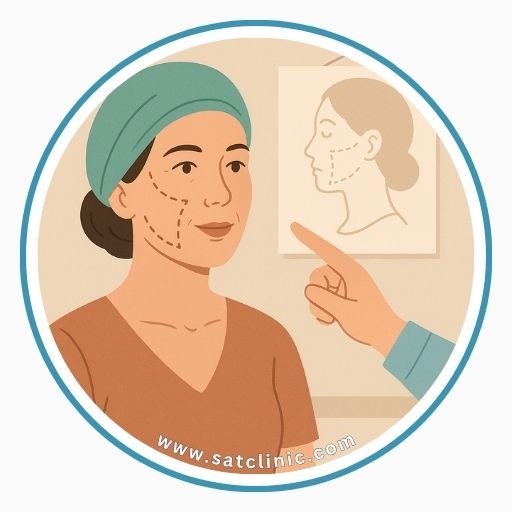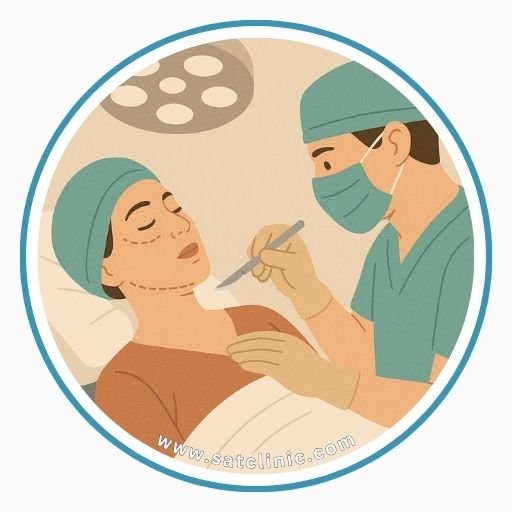An Overview of Facelift Surgery

A facelift is a type of cosmetic surgery aimed at improving the visible signs of aging in the face and neck. There are various types of facelift procedures, so choosing the right one for your needs and condition is essential. Only a qualified doctor can determine the best option for you.
What Is a Facelift Procedure?
The facelift, also known as rhytidectomy, is a general term for any surgical procedure designed to enhance the appearance of the skin by addressing aging signs in the face and neck. This is typically done by repositioning or removing excess skin or fat.
According to the American Society of Plastic Surgeons, facelift surgery is among the top five most common cosmetic surgical procedures, with over 120,000 procedures performed in 2019. Therefore, it is crucial for cosmetic surgeons to understand the history of the procedure, relevant anatomy, and technical nuances. Surgeons must have refined surgical techniques and excellent patient communication skills to achieve optimal results.
Benefits of Facelift Surgery

A facelift is a cosmetic surgical procedure designed to improve the appearance of the skin. However, it does not stop aging, treat surface wrinkles, sun damage, or uneven skin tone. Therefore, facelift surgery is a highly individualized procedure, and results vary depending on each person's face and goals.
Facelift surgery can address various signs of aging and offer several benefits:
- Eliminate sagging skin for a more refreshed and radiant complexion.
- Lift sagging cheeks along the jawline and create more defined mouth corners.
- Smooth deep lines and wrinkles between the cheeks and lips.
- Redistribute facial fat lost due to aging for a fuller, youthful look.
- Address double chin concerns, especially when combined with a neck lift.
Pre-Facelift Preparation

There are several steps involved in facelift surgery before and after the procedure. One of the most important is consulting your plastic surgeon, who will guide you through essential pre-surgery preparations.
First, you should choose an experienced plastic surgeon with a proven track record to gain the full benefits of a facelift. During your initial consultation, you and your surgeon will discuss your goals, medical history, allergies, current medications, and any habits that need to be adjusted.
Additionally, your surgeon may do or recommend the following:
- Review your medical history and check for chronic conditions. You'll be asked if you’ve had any prior cosmetic procedures, medications you're taking, and any complications you've experienced.
- Perform a physical exam and confirm your suitability for surgery, especially if you have chronic health conditions.
- Examine your face and neck, take photographs from different angles, assess facial bone structure and fat distribution to choose the best surgical approach.
- Discuss your goals and expectations and clarify whether they are realistic. Note that facelift surgery doesn't treat fine lines or correct facial asymmetry.
- Ask you to stop taking blood-thinning medications two weeks before surgery.
- Instruct you to stop eating after midnight on the night before the surgery.
- Ask you to wash your face and hair with soap and water on the morning of the procedure.
Steps of the Facelift Procedure

Most facelift procedures are performed in outpatient clinics, and your surgeon will typically need between 2 to 5 hours to complete the surgery. You can usually return home the same day. Facelift techniques have advanced significantly in recent decades as surgeons have developed a deeper understanding of facial anatomy. Generally, a facelift involves the following steps:
1. Anesthesia
Anesthesia is the first stage of the procedure. Most surgeons prefer general anesthesia, but some may use a combination of local anesthesia and mild sedatives.
2. Making the Incisions
The surgeon creates an incision behind your ear and along the hairline, extending from the front of the ear to above it. Additionally, a small incision under the chin fold may be made to target that area.
3. Reshaping Muscles and Tissues
To reposition and tighten underlying muscles and connective tissue, the surgeon lifts the skin outward, removes excess fat and skin, and may use sutures or adhesive to secure the tissues in their new position.
4. Closing the Incisions
Finally, the surgeon uses fine stitches to close the wounds and promote healing.
Recovery After Facelift Surgery

The day after surgery, your doctor will remove the drainage tube, change the wound dressings, and apply a topical antibiotic to the incisions. Two days later, the dressings will be replaced with a facial compression garment. After one week, the stitches will be removed and the healing site will be examined. Follow-up appointments typically continue for about two months.
During the first few days, it’s important to keep your head elevated, take pain relievers and anti-inflammatory medications, and apply cold compresses to your face to reduce swelling. You may experience some discomfort.
To minimize bruising and swelling, your doctor will wrap your face with a bandage and instruct you on how to care for the incision site. Pain medication may be prescribed if needed.
You will likely need two weeks to return to normal activities. Wait about four weeks before resuming more intense physical activities like exercise.
To maintain the benefits of your facelift, avoid sun exposure, apply skin care creams, and follow a healthy, balanced diet.
Risks and Side Effects of Facelift Surgery

Facelift surgery may involve certain risks and complications. Some issues can be treated with medication or by following the surgeon’s instructions, while others may leave lasting effects. The main side effects and risks of facelift surgery include:
- Hematoma (blood collection) or swelling under the skin within 24 hours, which may require immediate surgical intervention to prevent tissue damage.
- Bleeding during the surgery.
- Fluid accumulation in the face, causing swelling that usually subsides over time with treatment.
- Scarring from surgical incisions—often hidden in the hairline or natural facial creases, though some may become visible.
- Nerve injury affecting sensation or muscle movement, which can be temporary or permanent, potentially altering facial expressions.
- Hair loss near the incision site; may be temporary or long-term, possibly requiring hair transplant surgery.
- Skin loss due to poor blood circulation, treated with medication and proper wound care.
- Persistent numbness in certain facial areas.








